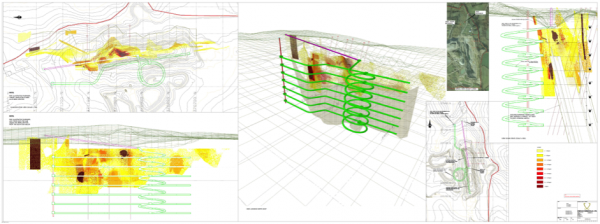Mine Development
A Galantas Gold Corporation wholly-owned subsidiary owns the freehold title to over 220 acres of land upon which the initial open-pit mine, processing plant, tailings facility and water clarification ponds are situated. The mine is now in the development stage with more than 3km of underground mine development completed. Test stoping has been completed with six stopes mined and backfilled using a narrow vein, modified Avoca longhole open stoping method. A total of 3,175 tonnes of mineralized material was successfully mined from the six stopes during this phase in a safe and controlled manner. Relatively low-grade areas of the mine were selected for the trial to assess the suitability of the mining method and also to serve as a training project for the locally trained mining operators. Trials have led to an optimized cycle of two days from the initial stope blast to completion of backfill, thus reducing the potential for dilution and also streamlining the process. This mining method can now be applied to more than 240 stopes which are already planned for the Kearney and Joshua zones.
The future of the Cavanacaw property lies in the development of an underground mine. An active program of drilling has partly assessed the gold and silver resource at depth. Detailed costing studies have been carried out to estimate the cost of underground development and these studies have been released within the 2014 Resource Assessment. The report has been released and estimates a high internal rate of return. (Report available to download below).
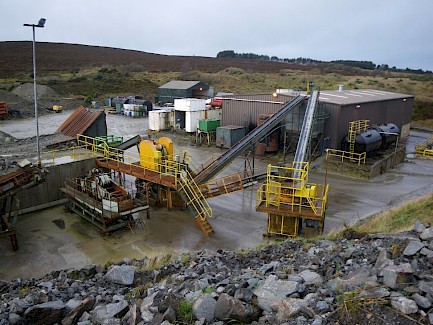 Given the potentially high grade and thicker widths within dilation zones identified by drilling below the current underground development, Galantas has prepared a Phase 1 mine plan which includes development mining at the Kearney and Joshua veins for an expected period of nine months, before anticipated ramp up to approximately 5,000 tonnes per month of both development and production (stope) mineralized material within 12 months of start-up.
Given the potentially high grade and thicker widths within dilation zones identified by drilling below the current underground development, Galantas has prepared a Phase 1 mine plan which includes development mining at the Kearney and Joshua veins for an expected period of nine months, before anticipated ramp up to approximately 5,000 tonnes per month of both development and production (stope) mineralized material within 12 months of start-up.
Mining the high-grade dilation zones is anticipated, with the goal of monthly production of 1,200 to 1,400 gold ounces after completion of development.
Galantas is scoping an expansion to the existing permitted mill to increase targeted annual production of 30,000 to 35,000 gold ounces.
Environmental protection is an important operating criterion for the mine and is managed in compliance with all environmental regulations. This ensures that the impact on the environment is minimized, monitored and held below fixed parameters. There is routine monitoring of water, dust, and noise. Development, health, safety and
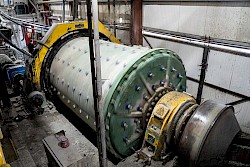 Galantas is committed to using environmental best practice, with all operating methods selected for maximum cost effectiveness and minimum environmental risk. Underground development to date has been concentrated on the Kearney Vein which hosts the mineralization, containing gold and silver, for further treatment. Mining is carried out by developing ore drives along the strike of the sub-vertical vein and then using longhole open stoping with backfill to extract the mineralized material between the ore drives, which are 12 metres apart vertically.
Galantas is committed to using environmental best practice, with all operating methods selected for maximum cost effectiveness and minimum environmental risk. Underground development to date has been concentrated on the Kearney Vein which hosts the mineralization, containing gold and silver, for further treatment. Mining is carried out by developing ore drives along the strike of the sub-vertical vein and then using longhole open stoping with backfill to extract the mineralized material between the ore drives, which are 12 metres apart vertically.
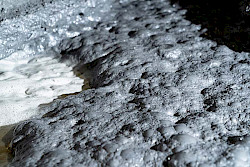 The mineralized material is transported to the processing plant, where it is crushed and milled to a fine powder, approximately 50% of which is less than 75µ. The milled material is pumped to the froth flotation circuit where, following the addition of specific reagents, the sulphide minerals are recovered in the float material (concentrate) using rougher, scavenger and cleaner cells. The non-sulphide material remaining after flotation – the tailings – is pumped to settling ponds, from which the supernatant water is returned to either the mine or the process plant for re-use. The concentrate is filtered through a plate filter press and the filter cake is contained in flexible intermediate bulk containers for shipment to the customer.
The mineralized material is transported to the processing plant, where it is crushed and milled to a fine powder, approximately 50% of which is less than 75µ. The milled material is pumped to the froth flotation circuit where, following the addition of specific reagents, the sulphide minerals are recovered in the float material (concentrate) using rougher, scavenger and cleaner cells. The non-sulphide material remaining after flotation – the tailings – is pumped to settling ponds, from which the supernatant water is returned to either the mine or the process plant for re-use. The concentrate is filtered through a plate filter press and the filter cake is contained in flexible intermediate bulk containers for shipment to the customer.
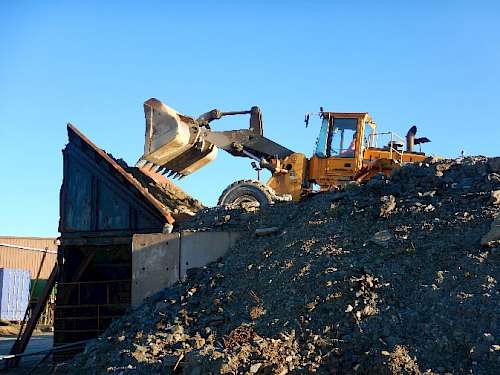 Samples are taken at regular intervals to ensure the efficacy of the process and these are analyzed in the in-house laboratory. The results are backed up by regular checks using independent laboratories.
Samples are taken at regular intervals to ensure the efficacy of the process and these are analyzed in the in-house laboratory. The results are backed up by regular checks using independent laboratories.
Management have identified potential uses for the clean tailings sand. These uses include the protection of pipes and conduit being laid in trenches during construction, a filler for bitumen based products, admixture for plaster based products or for the manufacture of soils in combination with other materials on site. Nearly half of future tailings sands production are expected to be used as permanent backfill during underground operations.
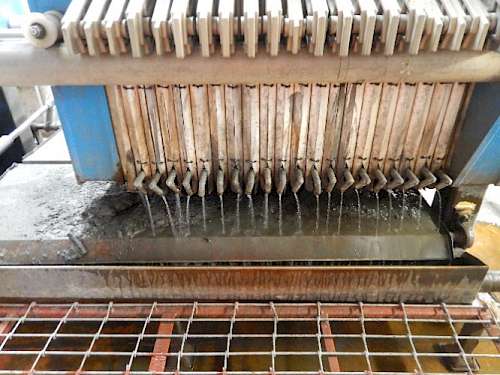 Mining of clean, barren country-rock creates an increase in volume of that material by virtue of the pore spaces created. The amount of increase of volume varies between 30% and 40%. The company is obliged to backfill the open pit, restore the site and dispose of the surplus rock from the site under restoration arrangements.
Mining of clean, barren country-rock creates an increase in volume of that material by virtue of the pore spaces created. The amount of increase of volume varies between 30% and 40%. The company is obliged to backfill the open pit, restore the site and dispose of the surplus rock from the site under restoration arrangements.
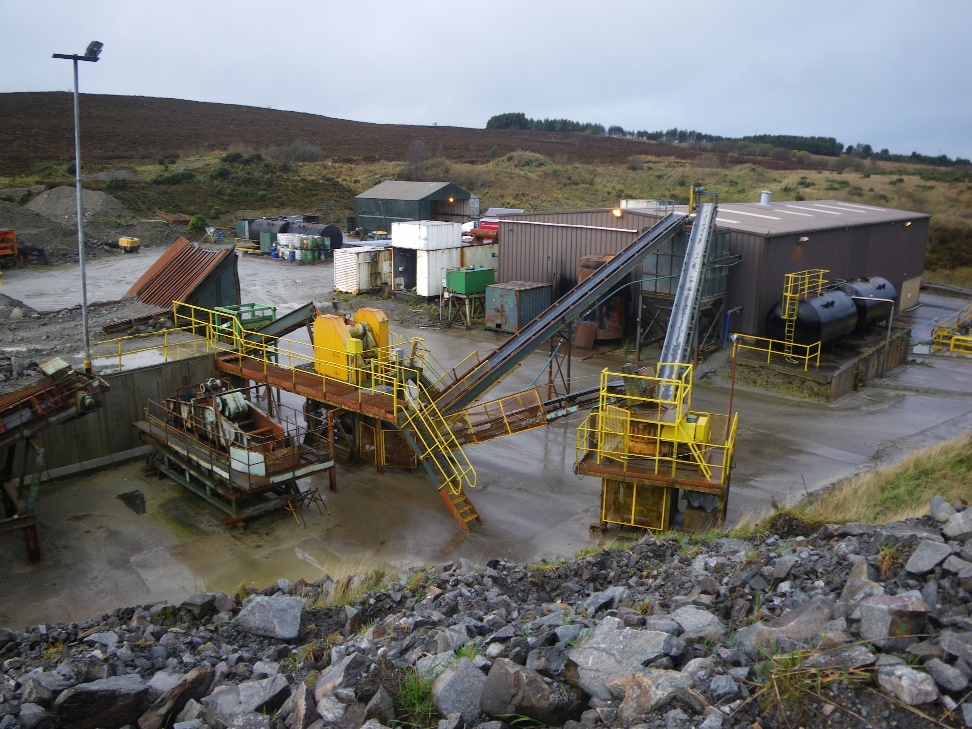 Planning permits have been received for mining underground, where the majority of resources lie. Galantas is actively engaged in mine development. It has a trained crew and equipment to carry out the necessary tasks. Additional labour and equipment will be added as the mine expands. Some limited mineralized material is produced in development of the gold veins and this feeds the processing plant on a part-time basis. The first concentrate derived from underground sources has been shipped.
Planning permits have been received for mining underground, where the majority of resources lie. Galantas is actively engaged in mine development. It has a trained crew and equipment to carry out the necessary tasks. Additional labour and equipment will be added as the mine expands. Some limited mineralized material is produced in development of the gold veins and this feeds the processing plant on a part-time basis. The first concentrate derived from underground sources has been shipped.
Environmental Impact Assessment
An Environmental Impact Assessment (EIA), based upon new data and data from 14 years of environmental monitoring, is complete and was examined as part of the planning process for underground mining. The EIA considers the processes involved, impact on water, air and noise amongst other environmental factors and is available on the Northern Ireland Planning Portal.
The figures below represent an early-stage iteration of plans and are presented to give a generalized picture of the underground development.
Detailed drawings are available via the Planning Service, DOENI Planning Portal (a third-party website). Registration is required.

